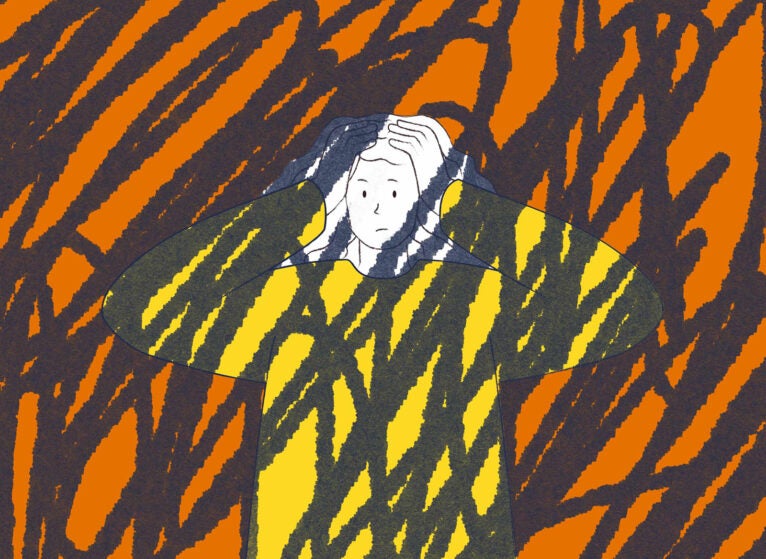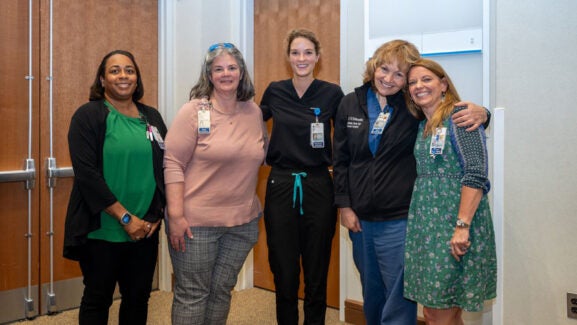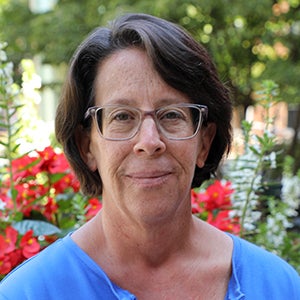

Q&A: Who Experiences Caregiver Stress, and How Can It Be Managed?
In the Emmy-nominated HBO Max medical drama “The Pitt,” medical resident Mel King attempts to comfort a distraught woman who’s overwhelmed caring for her disabled mother.
“You know, caretaker’s fatigue is a real thing,” King says. “You have to take care of yourself, otherwise you’re going to end up in here, too.”
Though the term caretaker’s fatigue — or caregiver stress — has gained recognition as a concept, the experience itself is all too familiar for many. To learn what it is, who is affected and how to manage it, UVA Today talked with University of Virginia School of Nursing Professor Paula Sherwood, a longtime neuroscience nurse who studies caregiver stress. In Sherwood’s research, she looks for markers of stress in caregivers, such as the level of cortisol stored in people’s hair, and develops interventions to provide support and relief.
What is caregiver stress?
Caregiver stress is the strain that family members feel when their loved one is diagnosed with a medical condition. It could be anything from Alzheimer’s disease to cancer to cardiovascular disease to having a child with neurodevelopmental disorders. One in four Americans is a caregiver of someone with a condition like this, and while some people manage the role just fine, many others struggle under the weight of an illness that doesn’t get better and for which there’s no relief in sight.
The term encompasses the shock of the initial diagnosis as well as the way that diagnosis changes families’ lives across the board. These medical diagnoses mean that roles and tasks often dramatically change within the family, finances change, and people’s social networks change, too. Their vision of the futures changes. Really, everything changes to some degree. For some folks, it’s not a big or long-lasting change and they have the resources to cope with it. For other folks, there’s a huge barrage of stressors that they now face.
How is it different from other kinds of stress?
I often explain it this way: If you’re walking down the street and you run into a bear, your mind is suddenly filled with fear. You’ve got shock, worry, anger, depression. It starts a physiological stress cascade in your body, which is the “fight, flight or freeze” response. The hormones in your body start pumping out molecules to help you fight whatever stressor that is. If you run into a bear, your cortisol will increase to give you extra energy to fight the bear. Your heart rate goes up, your blood pressure goes up. All of those things help prime your body to handle that bear. In normal cases, with an acute stressor, the “bear” is a short-term shock, but then things in the body return to normal. The heightened state is over.
But when you’re a family caregiver, the initial diagnosis is only the first step of that stress cascade. And those threats keep coming. You have to worry about treatments, mortality, how your loved one is going to change. For caregivers, that bear never goes away, which means their bodies continue to be in an elevated state, some degree of fight, flight, or freeze. Over time, that’s absolutely exhausting. It wears you out physically and emotionally.
Who tends to be most prone to caregiver stress?
A lot of research indicates that’s it’s spouses and those who live with the person for whom they provide care who tend to report high levels of stress. Caregivers who provide the greatest quantity of care, the most hours, or who face the most dramatic changes to their lives or who are caring for someone facing a terminal illness report higher levels of stress. We also know that rural caregivers experience high levels of stress, because care is harder to access both for themselves and the patient. Rural caregivers tend to have fewer resources to support them so their struggles are often more acute.
How does caregiver stress manifest?
Emotionally, caregivers can have really high levels of anxiety and depression compared to the general population.
We also know that caregivers don’t respond to vaccines as well, and experience depressed immune function, which makes them vulnerable to a host of infections and illnesses. They get more upper respiratory illnesses, like colds and flus. Caregivers have been shown to have higher levels of blood pressure, increased risk of heart disease, worse headaches, and tend to experience higher rates of acid reflux and pain.
A 1999 study showed that caregivers who are stressed are more likely to die when compared to caregivers who are not stressed. There have been other studies that replicate this, and some of them support that conclusion and others don’t. My goal, and the goals of other caregiver researchers at UVA, is to improve the quality and quantity of caregivers’ lives.
How can people manage this stress?
If you’re worried about caregivers’ physical health, you need to look at figuring out ways to help people cope better with being a caregiver. Coping skills need to lower emotional distress so that their brain is not constantly in fight or flight mode. And you have to help them be proactive about taking care of themselves. As healthcare professionals, we also have to be sure that our interventions to help don’t add to their stressors but actually help decrease them.
Research shows psychoeducational interventions help release and relieve stress. They don’t erase everything, but they do help. What we mean by “psychoeducational” is something where you not only teach caregiver skills, in terms of what to do at home with the patient, but you also provide support and counseling.
Getting caregivers to keep up with their own primary care visits can be challenging, but a lot of it has to do with ensuring they have access to primary care. Once they do, you have to make sure that they’re being taught how to advocate for their own health, that they’re aware of the risks and not blind to the fact that if they aren’t well they won’t be able to care for someone else.
Because in the end, if you don’t preserve caregiver health, you’re going to wind up with caregivers who are a lot sicker at the end of the care situation than they were at the beginning. You’ve basically created a new patient population. And caregivers that aren’t as healthy, emotionally or physically, are not going to be able to provide the same kind of care as those who are.
Latest News




